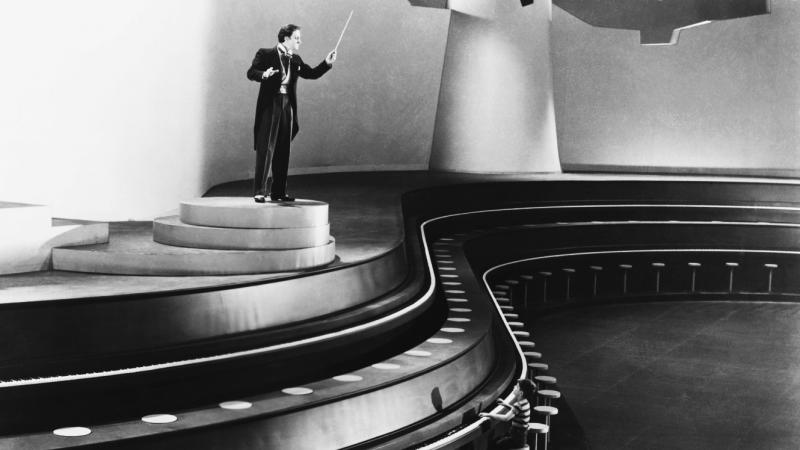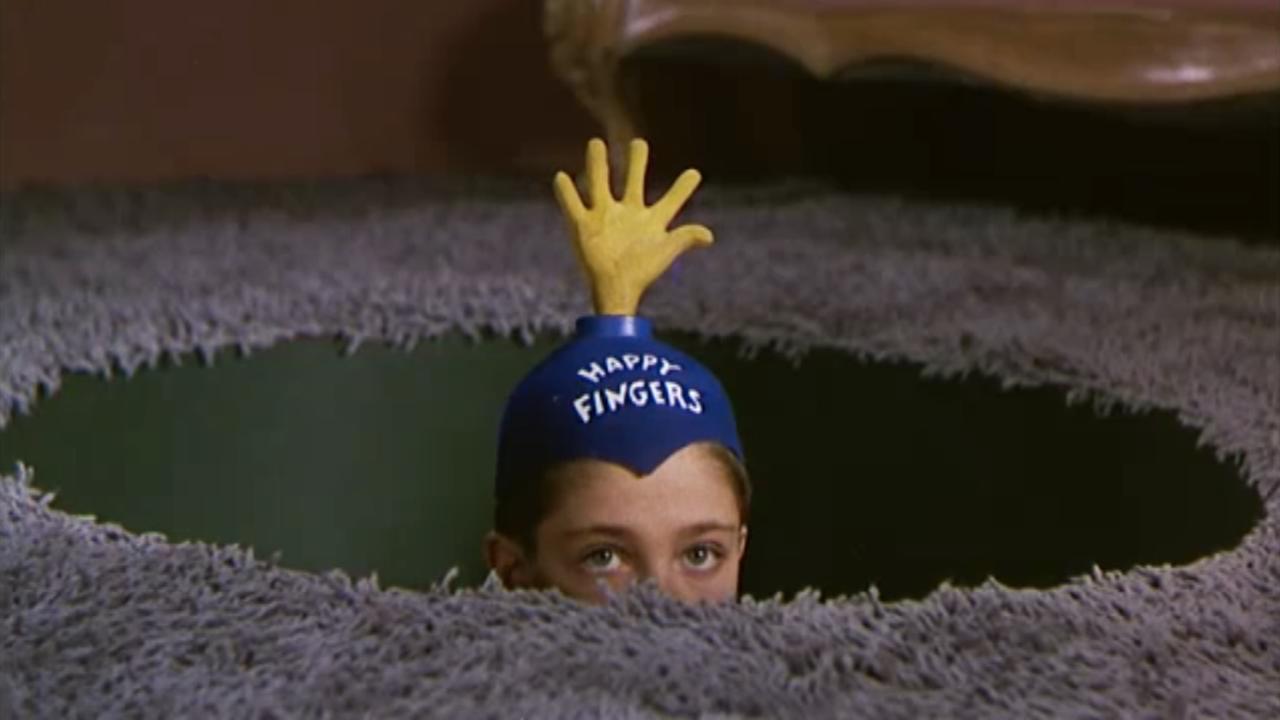DVD/Blu-ray: The 5000 Fingers of Dr T | reviews, news & interviews
DVD/Blu-ray: The 5000 Fingers of Dr T
DVD/Blu-ray: The 5000 Fingers of Dr T
A welcome return for Dr Seuss's mind-bending fantasy

There are lots of ideas bubbling away under the surface of The 5000 Fingers of Dr T. There would have been even more had the studio not panicked after a disastrous preview screening. Half the musical numbers were scrapped, subplots ditched and a new prologue and epilogue inserted. What remains of Roy Rowlands’s 1953 fantasy is described by singer Michael Feinstein in an extra on this release as “a mangled masterpiece”. The excised songs have been located, but the missing footage still hasn’t been found.
The film's component parts are promising: the screenplay was co-authored by Dr Seuss, and Rudolph Sternad’s production designs bring Seuss’s skewed world to queasy life. The score was written by the great Frederick Hollander, and we get Hans Conried’s Dr Terwilliger as one of the quintessential movie villains. How could this tale of a small boy held captive by a demonic piano teacher fail, what with Terwilliger enslaving 500 boys on a giant keyboard so that they can play five finger exercises for perpetuity? It’s a Whiplash for the under-tens.
Seuss's story was too dark for mainstream tastes
Besides escaping, Tommy Rettig’s plucky Bart (pictured below) also has to rescue his mother (a radiant Mary Healy), whi has been hypnotised by Terwilliger into forced marriage, aided by Peter Lind Hayes’ plumber Zabladowski. Along the way there's an insane "hypno duel" between Zabladowski and Terwilliger, plus a ballet set in the dungeon where all non-pianists are interred. One of them is West Side Story’s George Chakiris, playing a trombone whilst covered in green body paint. Terwilliger is routed, there's a massed rendition of Chopsticks, and all is revealed to have been a dream.
Seuss's story was too dark for mainstream tastes, the idea of children incarcerated by a tyrant in a fortress surrounded by barbed wire a little close to the bone. School buses disgorge their young passengers to be processed at the prison gates, and Terwilliger’s solemn order that Zabladowski be “disintegrated, atom by atom” has an uneasy resonance. The cuts make stretches of the film incoherent; I wanted to know more about the mysterious twin roller-skaters, conjoined by a long beard.
 Feinstein gets it right in a bonus interview, suggesting that “if you don't expect too much, you'll be overwhelmed.” The high spots make the film unmissable, its eye-popping visuals created decades before the advent of CGI. The songs are mostly memorable – notably a nightmarish number sung by a satanic lift operator, and Terwilliger’s ode to the joys of cross-dressing.
Feinstein gets it right in a bonus interview, suggesting that “if you don't expect too much, you'll be overwhelmed.” The high spots make the film unmissable, its eye-popping visuals created decades before the advent of CGI. The songs are mostly memorable – notably a nightmarish number sung by a satanic lift operator, and Terwilliger’s ode to the joys of cross-dressing.
Other extras include an entertaining audio commentary from film historians Glenn Kenny and Nick Pinkerton, and interviews with the son and daughter of the director and the producer. The short documentary A Little Nightmare Music demonstrates just how inventive much of Hollander's theremin-soaked score is. The restored image looks and sounds wonderful, and there’s an excellent, generously illustrated booklet – which doesn’t mention the anecdote about food poisoning causing chaos on set, or that Bart Simpson’s nemesis Sideshow Bob shares Dr T’s surname. Niggles aside, this is mandatory viewing.
Overleaf: Hans Conried sings "Dress Me"
There are lots of ideas bubbling away under the surface of The 5000 Fingers of Dr T. There would have been even more had the studio not panicked after a disastrous preview screening. Half the musical numbers were scrapped, subplots ditched and a new prologue and epilogue inserted. What remains of Roy Rowlands’s 1953 fantasy is described by singer Michael Feinstein in an extra on this release as “a mangled masterpiece”. The excised songs have been located, but the missing footage still hasn’t been found.
The film's component parts are promising: the screenplay was co-authored by Dr Seuss, and Rudolph Sternad’s production designs bring Seuss’s skewed world to queasy life. The score was written by the great Frederick Hollander, and we get Hans Conried’s Dr Terwilliger as one of the quintessential movie villains. How could this tale of a small boy held captive by a demonic piano teacher fail, what with Terwilliger enslaving 500 boys on a giant keyboard so that they can play five finger exercises for perpetuity? It’s a Whiplash for the under-tens.
Seuss's story was too dark for mainstream tastes
Besides escaping, Tommy Rettig’s plucky Bart (pictured below) also has to rescue his mother (a radiant Mary Healy), whi has been hypnotised by Terwilliger into forced marriage, aided by Peter Lind Hayes’ plumber Zabladowski. Along the way there's an insane "hypno duel" between Zabladowski and Terwilliger, plus a ballet set in the dungeon where all non-pianists are interred. One of them is West Side Story’s George Chakiris, playing a trombone whilst covered in green body paint. Terwilliger is routed, there's a massed rendition of Chopsticks, and all is revealed to have been a dream.
Seuss's story was too dark for mainstream tastes, the idea of children incarcerated by a tyrant in a fortress surrounded by barbed wire a little close to the bone. School buses disgorge their young passengers to be processed at the prison gates, and Terwilliger’s solemn order that Zabladowski be “disintegrated, atom by atom” has an uneasy resonance. The cuts make stretches of the film incoherent; I wanted to know more about the mysterious twin roller-skaters, conjoined by a long beard.
 Feinstein gets it right in a bonus interview, suggesting that “if you don't expect too much, you'll be overwhelmed.” The high spots make the film unmissable, its eye-popping visuals created decades before the advent of CGI. The songs are mostly memorable – notably a nightmarish number sung by a satanic lift operator, and Terwilliger’s ode to the joys of cross-dressing.
Feinstein gets it right in a bonus interview, suggesting that “if you don't expect too much, you'll be overwhelmed.” The high spots make the film unmissable, its eye-popping visuals created decades before the advent of CGI. The songs are mostly memorable – notably a nightmarish number sung by a satanic lift operator, and Terwilliger’s ode to the joys of cross-dressing.
Other extras include an entertaining audio commentary from film historians Glenn Kenny and Nick Pinkerton, and interviews with the son and daughter of the director and the producer. The short documentary A Little Nightmare Music demonstrates just how inventive much of Hollander's theremin-soaked score is. The restored image looks and sounds wonderful, and there’s an excellent, generously illustrated booklet – which doesn’t mention the anecdote about food poisoning causing chaos on set, or that Bart Simpson’s nemesis Sideshow Bob shares Dr T’s surname. Niggles aside, this is mandatory viewing.
Overleaf: Hans Conried sings "Dress Me"
The future of Arts Journalism
You can stop theartsdesk.com closing!
We urgently need financing to survive. Our fundraising drive has thus far raised £49,000 but we need to reach £100,000 or we will be forced to close. Please contribute here: https://gofund.me/c3f6033d
And if you can forward this information to anyone who might assist, we’d be grateful.

Subscribe to theartsdesk.com
Thank you for continuing to read our work on theartsdesk.com. For unlimited access to every article in its entirety, including our archive of more than 15,000 pieces, we're asking for £5 per month or £40 per year. We feel it's a very good deal, and hope you do too.
To take a subscription now simply click here.
And if you're looking for that extra gift for a friend or family member, why not treat them to a theartsdesk.com gift subscription?
more Film
 The Mastermind review - another slim but nourishing slice of Americana from Kelly Reichardt
Josh O'Connor is perfect casting as a cocky middle-class American adrift in the 1970s
The Mastermind review - another slim but nourishing slice of Americana from Kelly Reichardt
Josh O'Connor is perfect casting as a cocky middle-class American adrift in the 1970s
 The Perfect Neighbor, Netflix review - Florida found-footage documentary is a harrowing watch
Sundance winner chronicles a death that should have been prevented
The Perfect Neighbor, Netflix review - Florida found-footage documentary is a harrowing watch
Sundance winner chronicles a death that should have been prevented
 Blu-ray: Le Quai des Brumes
Love twinkles in the gloom of Marcel Carné’s fogbound French poetic realist classic
Blu-ray: Le Quai des Brumes
Love twinkles in the gloom of Marcel Carné’s fogbound French poetic realist classic
 Frankenstein review - the Prometheus of the charnel house
Guillermo del Toro is fitfully inspired, but often lost in long-held ambitions
Frankenstein review - the Prometheus of the charnel house
Guillermo del Toro is fitfully inspired, but often lost in long-held ambitions
 London Film Festival 2025 - a Korean masterclass in black comedy and a Camus classic effectively realised
New films from Park Chan-wook, Gianfranco Rosi, François Ozon, Ildikó Enyedi and more
London Film Festival 2025 - a Korean masterclass in black comedy and a Camus classic effectively realised
New films from Park Chan-wook, Gianfranco Rosi, François Ozon, Ildikó Enyedi and more
 After the Hunt review - muddled #MeToo provocation
Julia Roberts excels despite misfiring drama
After the Hunt review - muddled #MeToo provocation
Julia Roberts excels despite misfiring drama
 London Film Festival 2025 - Bradley Cooper channels John Bishop, the Boss goes to Nebraska, and a French pandemic
... not to mention Kristen Stewart's directing debut and a punchy prison drama
London Film Festival 2025 - Bradley Cooper channels John Bishop, the Boss goes to Nebraska, and a French pandemic
... not to mention Kristen Stewart's directing debut and a punchy prison drama
 Ballad of a Small Player review - Colin Farrell's all in as a gambler down on his luck
Conclave director Edward Berger swaps the Vatican for Asia's sin city
Ballad of a Small Player review - Colin Farrell's all in as a gambler down on his luck
Conclave director Edward Berger swaps the Vatican for Asia's sin city
 London Film Festival 2025 - from paranoia in Brazil and Iran, to light relief in New York and Tuscany
'Jay Kelly' disappoints, 'It Was Just an Accident' doesn't
London Film Festival 2025 - from paranoia in Brazil and Iran, to light relief in New York and Tuscany
'Jay Kelly' disappoints, 'It Was Just an Accident' doesn't
 Iron Ladies review - working-class heroines of the Miners' Strike
Documentary salutes the staunch women who fought Thatcher's pit closures
Iron Ladies review - working-class heroines of the Miners' Strike
Documentary salutes the staunch women who fought Thatcher's pit closures
 Blu-ray: The Man in the White Suit
Ealing Studios' prescient black comedy, as sharp as ever
Blu-ray: The Man in the White Suit
Ealing Studios' prescient black comedy, as sharp as ever
 The Woman in Cabin 10 review - Scandi noir meets Agatha Christie on a superyacht
Reason goes overboard on a seagoing mystery thriller
The Woman in Cabin 10 review - Scandi noir meets Agatha Christie on a superyacht
Reason goes overboard on a seagoing mystery thriller

Add comment